Establish Consistency in Operations: The Ultimate Guide to Process Standardization

Sorry, there were no results found for “”
Sorry, there were no results found for “”
Sorry, there were no results found for “”
You’ve come up with an excellent way of filing documents in your company—it’s quick and easy to implement. But your coworker has also developed a unique system, which happens to be much different than yours.
Process standardization is a perfect remedy for the uncertainty that comes with disorderly workflows. It lets you outline clear, uniform, and consistent rules and procedures for completing tasks and executing operations across your organization.
How does process standardization work? And how it can benefit your company? We’ll discuss steps for improving the standardization of processes and share some handy tips to help you get on the path to success. 😍
Process standardization is the practice of establishing rules your employees should follow when faced with specific tasks and responsibilities. It’s based on the idea that companies must maintain a certain level of uniformity to ensure operations are conducted with maximum efficiency and productivity.
The goal is to enable every person within your company to handle business processes in the same way, securing maximum consistency and reducing the risk of mistakes.
An excellent, easy-to-understand example of process standardization is McDonald’s. With over 40,000 restaurants worldwide, you’d think there might be a few variations in how they make their iconic Big Mac burger.
But think again! Whether you go to a McDonald’s in the U.S., Serbia, or Australia, your Big Mac will taste just the same! It’s all thanks to their uniform, highly standardized processes that ensure you get the quality and service you expect, every time. 🍔
If done right, process standardization can bring about an array of positive outcomes, from improving service or product quality to optimizing resource utilization and even meeting compliance requirements. Let’s take a closer look at some of the key benefits that make process standardization so important:

Choosing to embark on the journey of process standardization is a vital first step toward jumpstarting efficiency and productivity, keeping your team happy, and boosting customer satisfaction. However, understanding how to standardize business processes is just as significant.
That’s why we’re here, ready to share some battle-tested best practices through a simple, step-by-step guide. We’ll be using ClickUp, a first-class task and project management tool that makes process standardizations a breeze.
Every process standardization effort starts with figuring out which business processes require standardization in the first place. Not all procedures are equally important, and you can’t standardize them all at once, so you need to prioritize.
Analyze your workflows and identify business processes that bring the most value to your company—these are standardized processes that stand to benefit the most from standardization.
For example, you might discover that your customer support department employs different methods to solve the same issues, i.e., arrive at the same outcomes. Your next step is to gather the team and pinpoint the most efficient process for handling a specific customer service task.
You can do that and much more using ClickUp Docs—a unique document management feature for creating, editing, sharing, and storing relevant documents. Create a ClickUp Doc for each process, invite relevant team members to contribute, and develop standardization ideas in real-time.
You can assign resulting tasks directly in the document, by converting text into trackable assignments or tagging team members with comments to improve business processes.

Having your existing processes in writing is a necessary first step—visualization brings your process documentation game to another level. For that, you can use ClickUp Whiteboards, i.e., digital canvases ideal for brainstorming, visual collaboration, and unleashing creativity.
Use Whiteboards to turn concepts into ideas in real-time, add notes, and discuss the best approaches to process standardization with your team.

Process standardization isn’t as easy as saying, “This is how we’ll complete this task from now on.”
It often involves adjusting and reinventing standardized processes or even coming up with brand-new ones. Most importantly, you can’t expect to see the results of your standardization efforts overnight.
To stay on the right course, you need clear, measurable process standardization goals. Setting such goals guides your efforts and helps you track progress. Of course, these goals are merely guidelines—you can adjust them over time to fuel continuous improvement.
ClickUp Goals is exactly what you need to keep the team on track and connect your work to your objectives. The feature helps you set Targets and measure success with ease.
All you need to do is link tasks or lists to a Goal, and ClickUp will automatically track progress as you complete them. 🏅

Use ClickUp’s folders to organize and manage Goals and track sprint cycles and OKRs, add unique descriptions to categorize Goals, set deadlines, and share your Goals with relevant team members.
Process mapping helps you visualize a process, identify its efficiencies and areas for improvement, and outline sequences of events and tasks. As such, process mapping has an important place in process standardization—it helps you understand processes, spot inconsistencies, identify the best practices, and make new rules based on them. ✨
Map out your processes easily with ClickUp Mind Maps, a unique option that lets you plan, organize, and connect ideas, tasks, and projects. These maps feature a drag-and-drop design, letting you draw connections and create unique visualizations.
Choose between task-based or node-based Mind Maps, share them with coworkers, and adjust them as necessary without breaking a sweat.
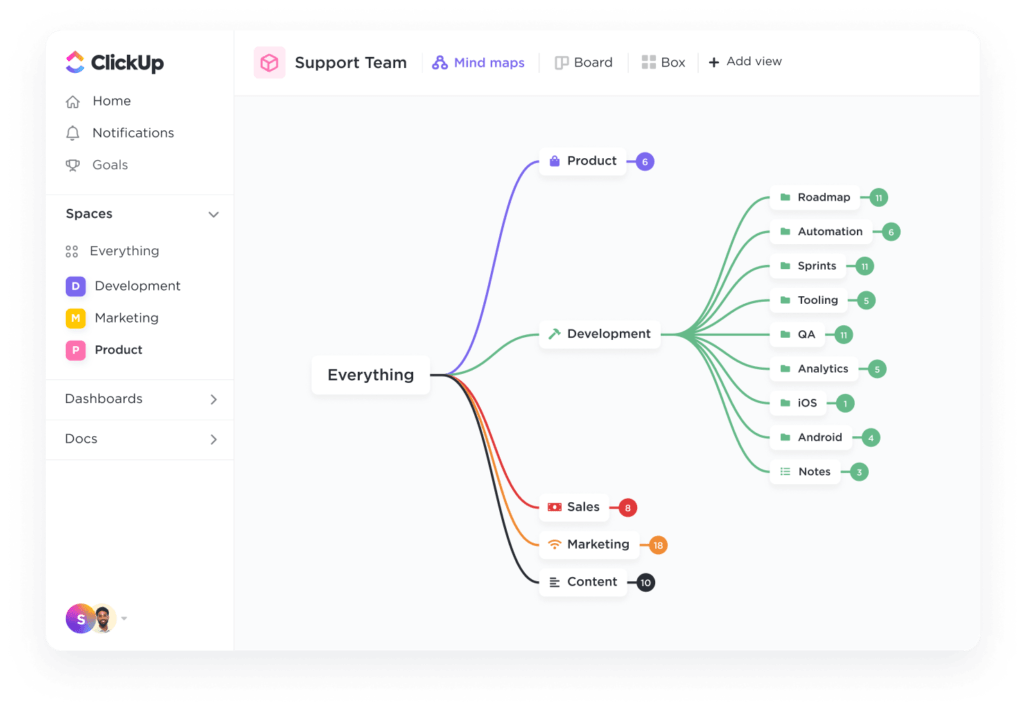
Don’t want to deal with creating Mind Maps from scratch? ClickUp templates come to the rescue! Their premade sections guide you through the entire process-mapping exercise.
We recommend the ClickUp Process Map Whiteboard Template and the ClickUp PDCA Process Map Template, as both help you break down your processes into categories for easier management.
Standard operating procedures (SOPs) are at the heart of process standardization as they’re the ones that guarantee consistency and improved efficiency. You’ll use them to outline step-by-step instructions for handling different tasks and activities.
Considering the importance of SOPs, you need to be extra careful when drafting them. They should be concise and detailed, leaving no room for uncertainties and what-ifs.
Fall back on ClickUp Docs once again to draft your SOPs—add relevant team members to your Doc and create comprehensive guidelines on handling different situations and tasks within your company. Collaborate with your team in real-time, leave comments, and come up with procedures that bring the most value.
As drafting top-notch SOPs requires some skill, you may feel more confident using ClickUp SOP templates. For example, you could use the ClickUp SOP Template—this Doc template contains instructions on what to include in each section of the document.
That way, you minimize the risk of crucial info falling through the cracks.
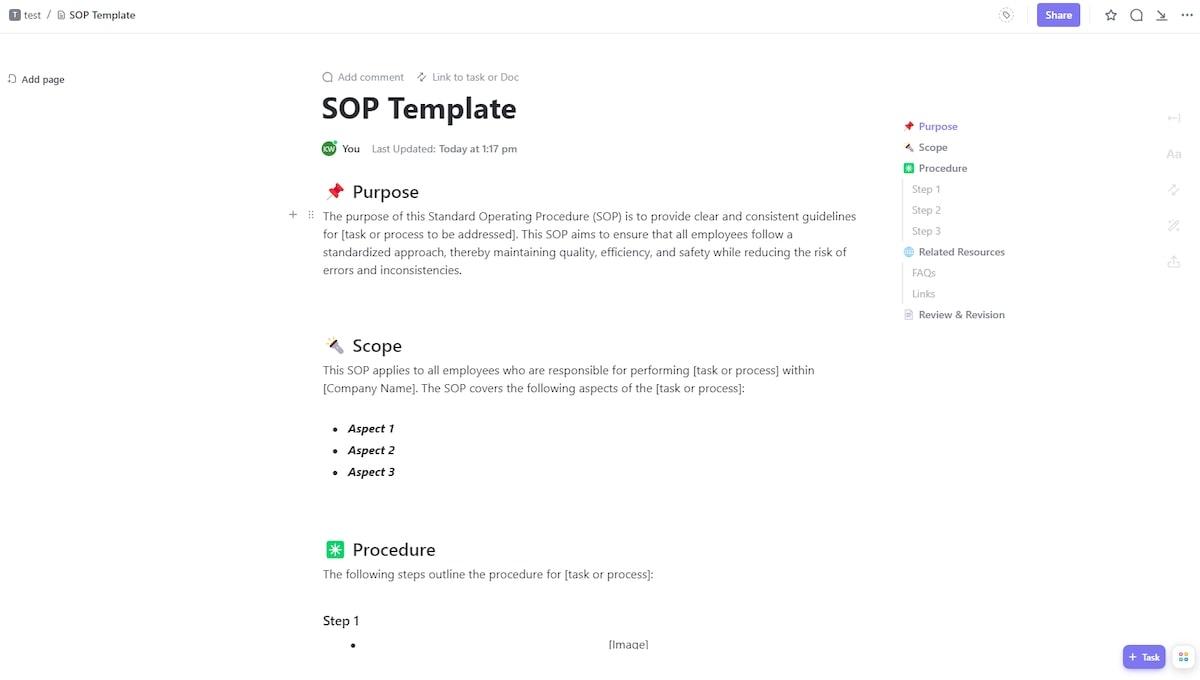
You could also use the ClickUp Standard Operation Procedures Template. This is another Doc template that helps you standardize processes like onboarding, training, and promoting employees.
Does your team invest a lot of time into repetitive tasks that don’t bring much value to your company? If yes, there’s an easy way to change that and let your employees focus on more important duties—ClickUp Automations.
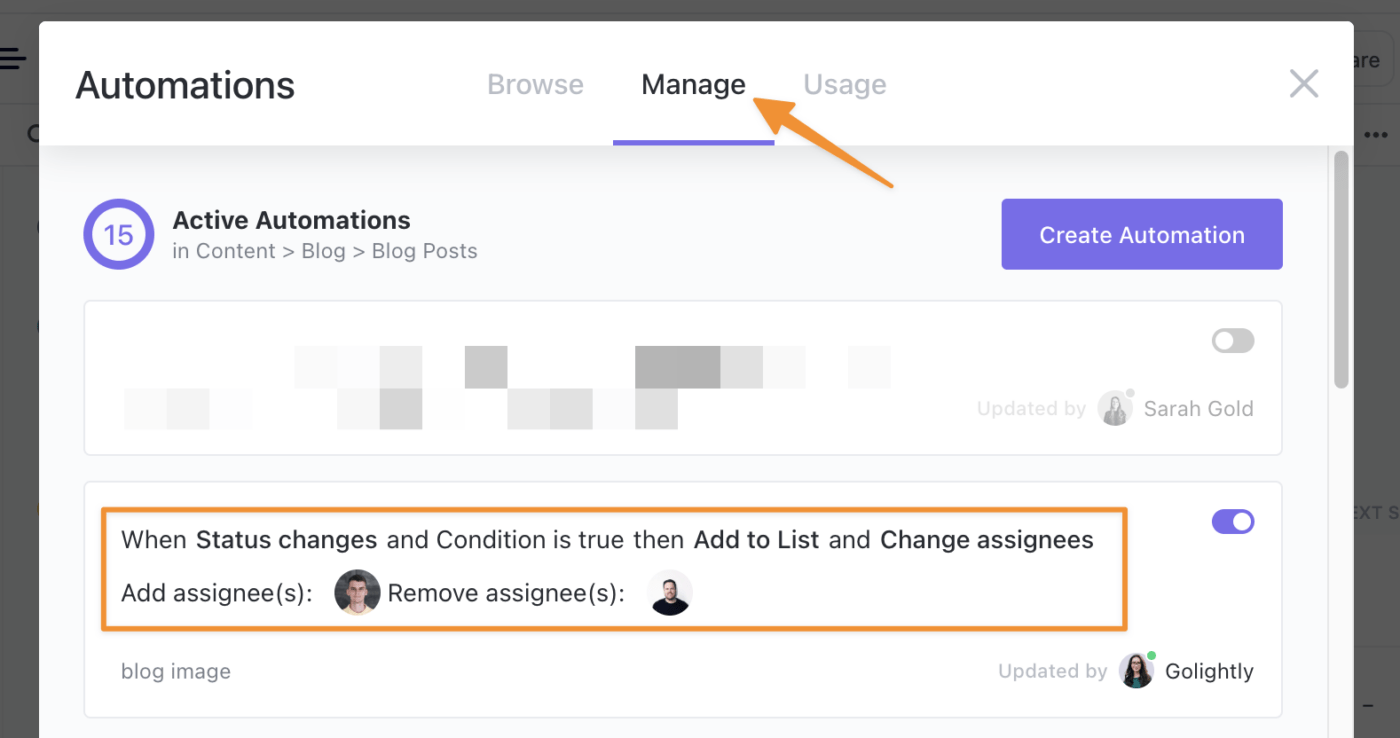
Automations let you enhance productivity, minimize the risk of errors, and ensure your processes are streamlined. They consist of:
ClickUp gives you several options for using Automations. If you want to achieve a specific result, you can create Custom Automations. Or, you can take a shortcut and use Automation templates with premade triggers and actions. They’re customizable and adapt well to your processes.
If your Automation is connected to another app like Calendly, GitHub, or Hubspot, you can always create an Integration Automation.
Standardizing processes often means significantly changing how your teammates approach tasks. Help them wrap their heads around these changes through effective communication. This means you should have everything in writing and update stakeholders on every detail related to their work.
Moreover, if the process standardization involves using new tools and procedures, make sure to train your team properly. That way, they can confidently approach new processes and be 100% sure they know what they’re doing.

ClickUp helps you communicate with your team and maintain transparency. You have the Chat view, where you can share updates, assign action items, and attach links and files.
You can also add relevant people to ClickUp Docs and ClickUp Whiteboards, ask them to pitch in their two cents about standardizing a process, and include them in the decision-making process.
If your team often communicates via email, you can use the Email in ClickUp ClickApp and send and receive emails without leaving the platform to centralize your work. 📩
ClickUp process documentation templates can help you outline every process in detail and share them with stakeholders. Our recommendations are the ClickUp Process Plan Document Template and the ClickUp Create Process Efficiently Template.
You’ve created standard operating procedures, discussed them with your team, and set your plans in motion. But your work doesn’t end here. To ensure continued success, you need to monitor and analyze it closely.
With ClickUp Dashboards, you can. This is your control center for observing and tracking the performance of every process within your company. Use Dashboards to monitor your team’s workload and performance, visualize resources, plan and manage goals, and gain detailed insights into every aspect of a process.
Choose from 50+ available widgets to monitor specific aspects of your processes and spot potential areas of improvement.
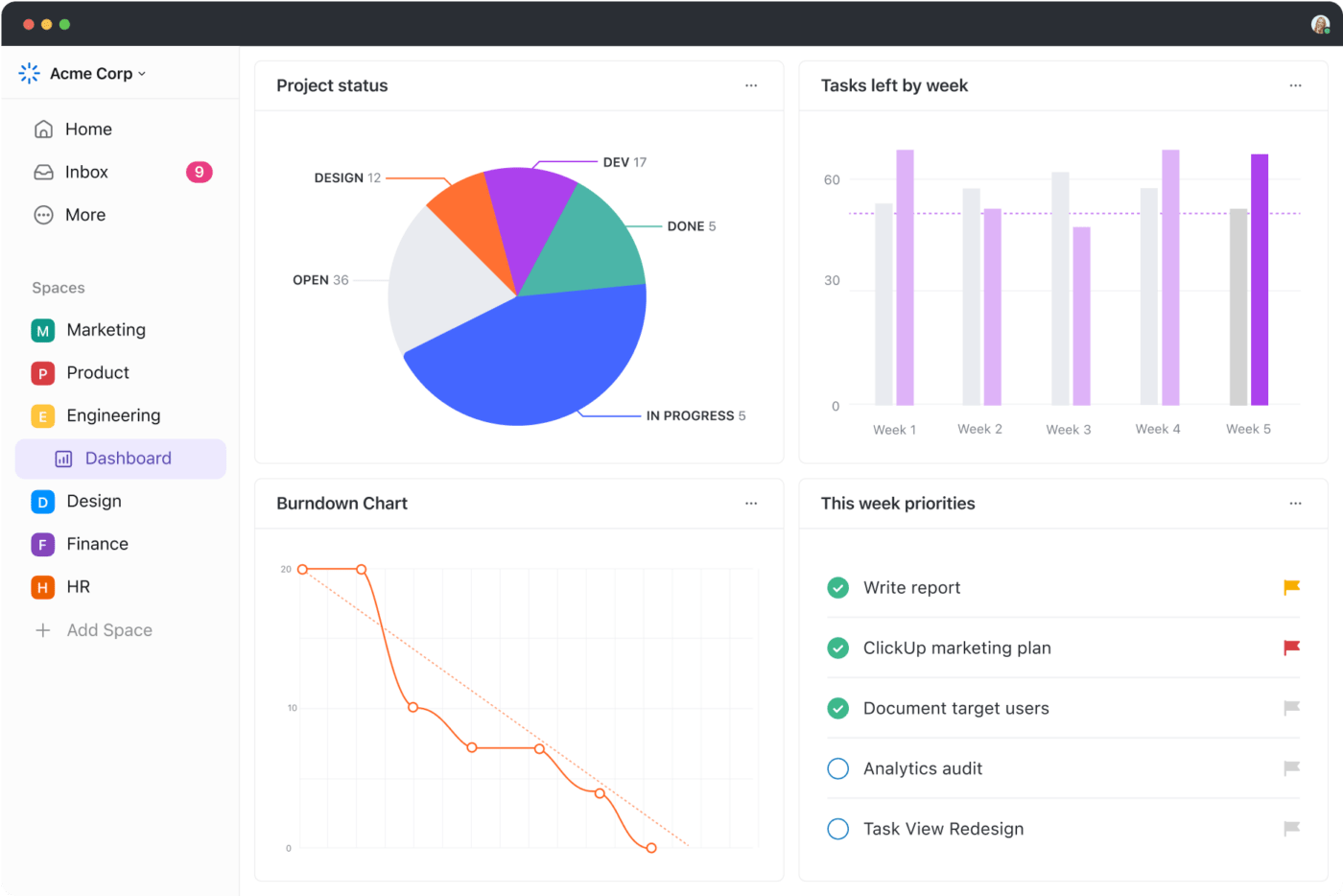
We’ve covered the theoretical part of process standardization. Let’s see how it works in practice using two real-life examples.
Let’s observe a customer support team in a company that offers a subscription-based media streaming platform. Their job is to respond to emails and provide accurate and relevant information to current and potential customers.
The team consists of 10 people, and everyone has their own way of responding to customer emails. For example, Jenny maintains a casual, cordial tone, while John likes to keep things professional.
Having these multiple personalities and approaches on the team can confuse customers and leave a negative impression, as they never know what to expect. Plus, the team often gets busy, so some customer emails may get lost in the chaos.
Standardizing processes on how you handle customer requests via email can help you save time, be more productive, and ensure consistency.
You’d start by analyzing current business processes. Consider the response times, ticket creation and categorization, prioritizing, and collecting customer feedback. Visualize the entire process to understand it better and pinpoint areas that require your attention.
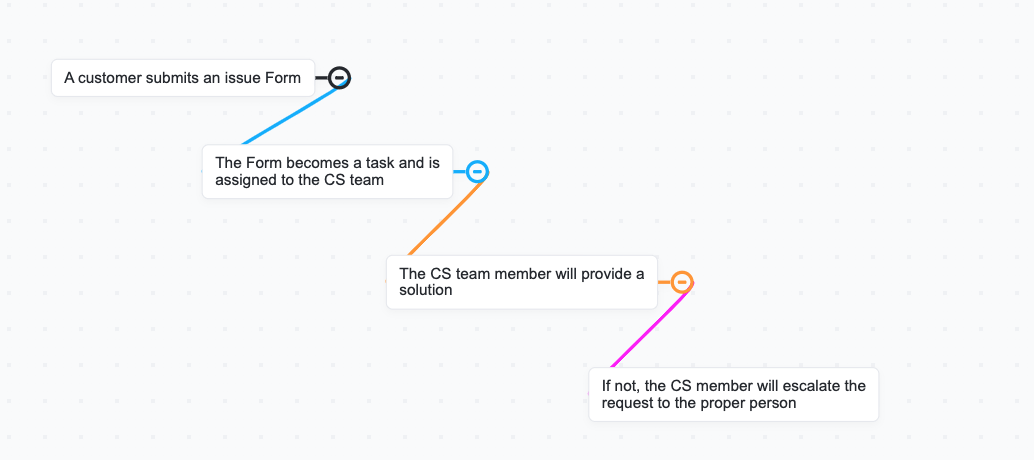
Now it’s time to set goals. For example, if your customers complained of slow response times, you’d want to focus on improving this metric. Ensure your goals are measurable so that you can track progress over time.
Next, you should create SOPs. Document how customer service representatives should reply to emails. You can use templates to create a detailed step-by-step guide on handling different types of emails. Moreover, you can develop ways to categorize and prioritize emails and ensure every customer gets a response.
Automations can play a valuable role here—use them to send out acknowledgment emails to customers, ensure the emails reach the right representative, and ask for customer feedback.
Share your SOPs with the entire team, review them together, and answer any questions representatives may have. Use the SOPs for onboarding new employees and to better solidify your business operations.
Lastly, don’t forget to revisit your businesses processes occasionally to ensure they’re still working. Do this by analyzing feedback not just from your customers but your team as well.
Let’s imagine you’re running a family-owned burger joint with decades of experience. The restaurant is known for delicious food and generous portions.
However, the owners received several complaints recently regarding their burgers—it seems that the quality of the product often varies, especially concerning the taste.
You want to standardize the burger preparation process. You’ll start by analyzing the current procedure—you’ll get an overview of everything from procurement to cooking times, toppings, and portions.
During the analysis, you’ll likely find the “weakest link”—that could be inconsistent cooking times, varying meat quality, or stale ingredients. You’ll create a process map to visualize it and understand the best way to improve.
Then you’ll come up with SOPs. For example, you can create a list of approved suppliers for burger patties, outline steps for organizing the grilling section, define cooking times, and describe the bun-toasting process. You could also discuss food safety and adequate portions.
Once you’ve defined SOPs, call a meeting where you’ll discuss them with cooks and assistants. You can also print out the SOPs and keep them near the workstation so everyone can read them when necessary.
Hold regular meetings with the staff to ensure the process is efficient, and ask your guests for feedback frequently. These simple adjustments make overall business operations run more efficiently.
Process standardization is an excellent way to optimize workflows, save time and money, and keep your team and customers happy. However, it often requires hard work and attention to detail.
With its robust options for documenting, visualizing, and managing processes, ClickUp has everything you need to bring structure into your workflows and keep your team on the same page.
Sign up for ClickUp today, explore its outstanding features, and start revolutionizing your process standardization. 🔁
© 2026 ClickUp